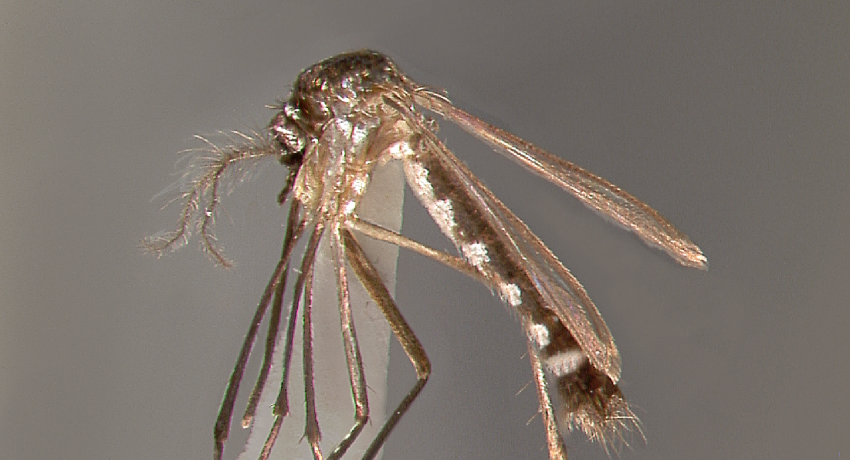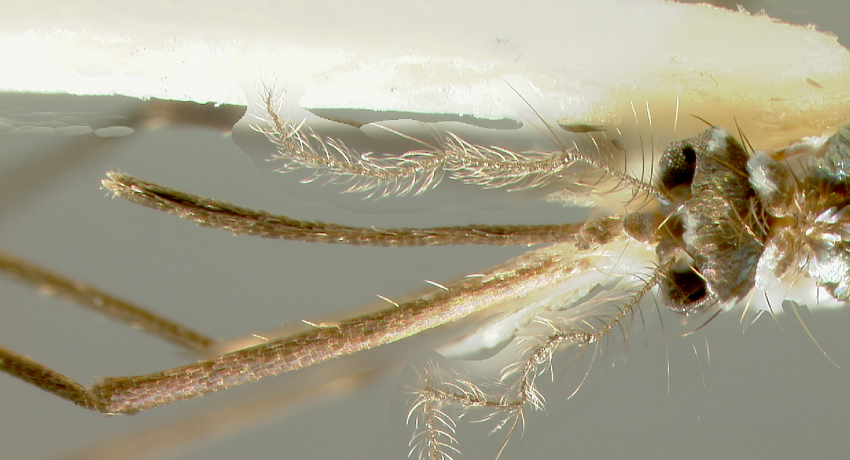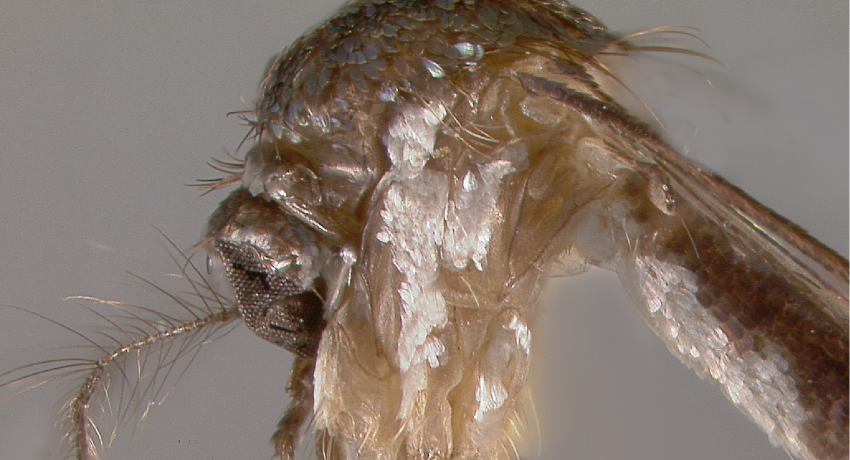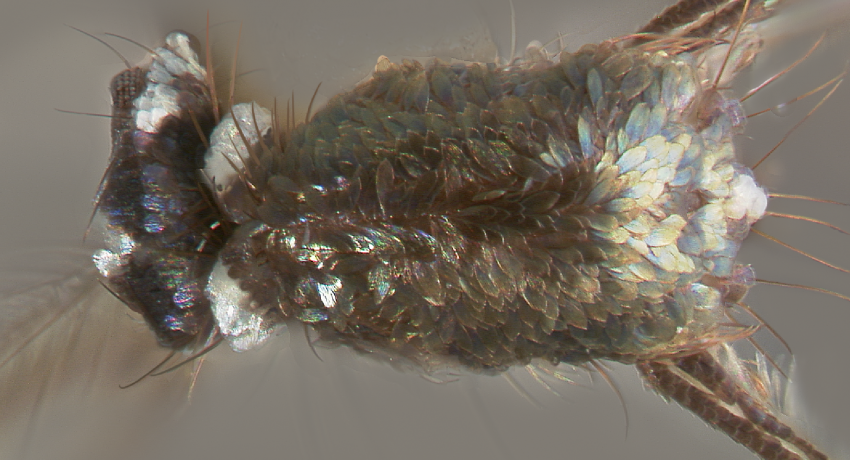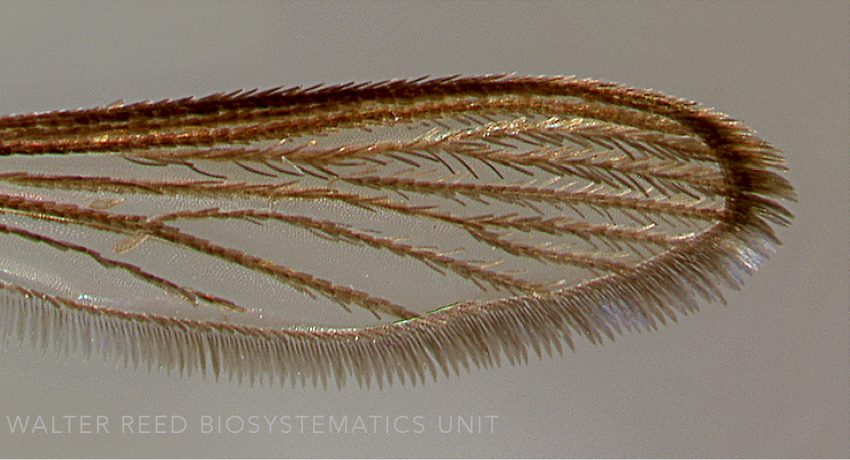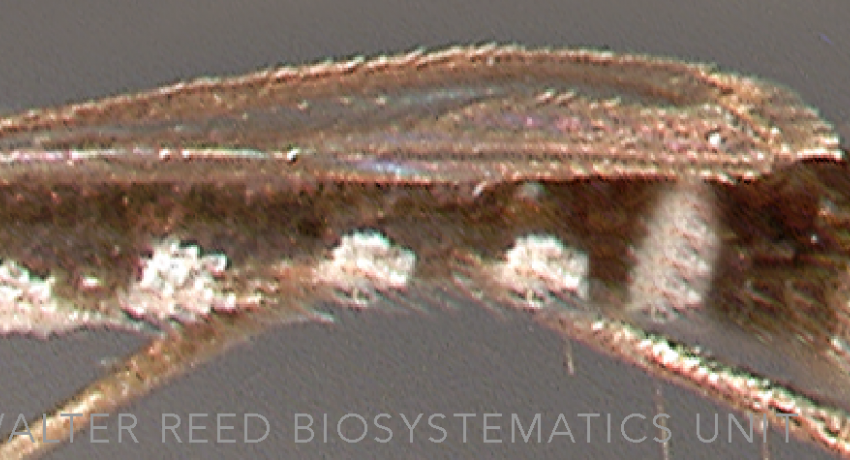AUSTRALASIAN, ORIENTAL & PALEARCTIC REGIONS
Generic abbreviation: Hz.
Type species: Heizmannia scintillans Ludlow
Etymology: C.L. Heizmann
The forest-associated Aedine genus Heizmannia comprises 39 species, further subdivided into two subgenera: Heizmannia (33 species) and Mattinglyia (6 species). Mostly distributed in the Oriental Region, some species do extend into the southeastern Palearctic. The only Australasian representative—Heizmannia aurea—is endemic to Halmahera island in the Moluccas. Heizmannia species are amongst the most handsome of Aedines—vividly decorated with multi-colored, iridescent scales more commonly associated with the Neotropical Sabethines.
DIAGNOSTIC CHARACTERS (Click photos to view; mouse over and click large photo to zoom in.)
ADULT (illustrated): Head: Erect scales low on occiput, occasionally absent. Thorax: Scutum with broad scales; acrostichal and dorsocentral areas without setae; head vertex with dark broad appressed scales, patches of broad white or silver scales laterally and between eyes; prespiracular setae absent; postspiracular setae mostly absent; upper mesokatepisternal setae absent; lower mesepimeral setae present; subspiracular, postspiracular and paratergal scales present; scales present on laterotergite. Wing: Vein 1A terminates beyond mediocubital crossvein; alula dorsal edge with broad scales; upper calypter fringed with setae. Legs: Mostly dark. Abdomen: Abdominal terga with distinct white or silver triangular basolateral markings.
LARVA (not illustrated): Head: Maxilla with brush or bundle of filaments. Terminal segments: Comb with ≤20 scales; pecten with c. 15 spines; seta 1-S long, usually 1–3 branched, inserted at or beyond midpoint of siphon; saddle incomplete.
TAXONOMIC KEYS
Barraud 1934 (India, Sri Lanka, Myanmar)
Mattingly 1957d (Indomalayan region)
Thurman 1959 (Thailand)
Delfinado 1966a (Philippines)
Tanaka et al. 1979 (Japan)
Rattanarithikul & Harrison et al. 2005 (Thailand)
Rattanarithikul et al. 2010 (Thailand)
![]()
WRBU – Genera – Global – Larva
![]()
WRBU – Genera – IndoMalaya – Adult
![]()
WRBU – Genera – IndoMalaya – Larva
![]()
WRBU – Genera – Oriental – Adult
![]()
WRBU – Genera – Oriental – Larva
![]()
WRBU – Genera – Eastern Palearctic – Adult
![]()
WRBU – Genera – Eastern Palearctic – Larva
Exemplar DNA sequences
Hz. (Hez.) chandi COI; AY917208
Hz. (Mat.) discrepans COI: AY834242, EU259296
BIONOMICS
Immatures
Typical habitats for Heizmannia immatures include water collections in treeholes (e.g., Hz. chandi), in split, cut, and insect-bored standing bamboo, and ground sites including crabholes, coconut shells, rubber tapping containers, fallen or split bamboo, and in small ground pools.
Adults
Remarkably little is known on the adult bionomics of Heizmannia species but in the rubber plantations of southeast Asia, females can become a nuisance, biting workers during the day.
*Associated pathogens: This list reports bacteria, viruses, and parasites recovered from, or experimentally passed through this species, and does not imply field vector status.
IMPORTANT REFERENCES (full citations below)
Ludlow 1905a: 130 (as genus)
Brunetti 1914: 61 (Heinzmannia; emendment)
Theobald 1910a: 31 (Bolbodeomyia, as genus)
Barraud 1934 (taxonomy, keys; India, Sri Lanka, Myanmar)
Mattingly 1957d (keys; Indomalayan region)
Thurman 1959 (taxonomy; Thailand)
Delfinado 1966a (taxonomy, keys; Philippines)
Mattingly 1970a (revision; SE Asia)
Reinert 1973f (taxonomy, classification)
Tanaka et al. 1979: 247 (keys; Japan)
Lee et al. 1988b (taxonomy, classification, bionomics; Australasia)
Reinert 2002b (F genitalia*)
Reinert et al. 2004 (phylogeny, classification)
Rattanarithikul & Harrison et al. 2005 (F, L; taxonomy, keys, bionomics; Thailand)
Reinert et al. 2009 (classification, phylogeny)
Rattanarithikul et al. 2010 (F*, L*; keys, bionomics; Thailand)
Wilkerson et al. 2015 (classification, phylogeny)
Soghigian et al. 2017 (phylogeny)
VALID SUBGENERA
Heizmannia Ludlow [Hez.]
Mattinglyia Lien [Mat.]
CURRENT GENERIC & SUBGENERIC SYNONYMS
Heizmannia
syn. Bolbodeomyia Theobald 1910a: 31 (as genus). Type species: Bolbodeomyia complex Theobald.
CITED REFERENCES
Barraud, P. J. (1934). The fauna of British India, including Ceylon and Burma. Diptera. Vol. 5. Family Culicidae, tribes Megarhinini and Culicini (Vol. 5). London: Taylor and Francis.
Brunetti, E. (1914). Critical review of genera in Culicidae. Records of the Indian Museum, 10(2), 15–73.
Delfinado, M.D. (1966a). The culicine mosquitoes of the Philippines, tribe Culicini (Diptera, Culicidae). Memoirs of the American Entomological Institute, 7, 1–252.
Lee, D.J., Hicks, M.M., Debenham, M.L., Griffiths, M., Bryan, J.H., & Marks, E.N. (1988b). The Culicidae of the Australasian region. Volume 9. Commonwealth Department of Health, School of Public Health and Tropical Medicine Monograph Series, 2.
Ludlow, C.S. (1905a). Mosquito notes. III. Canadian Entomologist, 37, 94–102, 129–135.
Mattingly, P.F. (1957d). The culicine mosquitoes of the Indomalayan Area. Part II. Genus Heizmannia Ludlow. Bulletin of the British Museum (Natural History) Entomology, 1–57.
Mattingly, P.F. (1970a). Contributions to the mosquito fauna of Southeast Asia. VI. The genus Heizmannia Ludlow in Southeast Asia. Contributions of the American Entomological Institute, 5(7), 1–104.
Rattanarithikul, R., Harbach, R.E., Harrison, B.A., Panthusiri, P., Coleman, R.E., & Richardson, J.H. (2010). Illustrated keys to the mosquitoes of Thailand VI. Tribe Aedini. Southeast Asian Journal of Tropical Medicine and Public Health, 41(1), 1–225.
Rattanarithikul, R., Harrison, B.A., Panthusiri, P., & Coleman, R.E. (2005). Illustrated keys to the mosquitoes of Thailand. I. Background; geographic distribution; lists of genera, subgenera, and species; and a key to the genera. Southeast Asian Journal of Tropical Medicine and Public Health, 36(1), 1–80.
Reinert, J.F. (1973f). Notes on the genus Heizmannia and the inclusion in subgenus Mattinglyia of two species previously placed in Aedes subgenus uncertain (Diptera: Culicidae). Mosquito Systematics, 5(1), 14–23.
Reinert, J.F. (2002b). Comparative anatomy of the female genitalia of genera and subgenera in tribe Aedini (Diptera: Culicidae). Part X. Genus Heizmannia Ludlow. Contributions of the American Entomological Institute, 32(5), 1–15.
Reinert, J.F., Harbach, R.E., & Kitching, I.J. (2004). Phylogeny and classification of Aedini (Diptera: Culicidae), based on morphological characters of all life stages. Zoological Journal of the Linnean Society, 142, 289–368.
Reinert, J.F., Harbach, R.E., & Kitching, I.J. (2009). Phylogeny and classification of tribe Aedini (Diptera: Culicidae). Zoological Journal of the Linnean Society, 157(4), 700–794.
Soghigian, J., Andreadis, T.G., & Livdahl, T.P. (2017). From ground pools to treeholes: convergent evolution of habitat and phenotype in Aedes mosquitoes. BMC Evolutionary Biology, 17, 262.
Tanaka, K., Mizusawa, K., & Saugstad, E.S. (1979). A revision of the adult and larval mosquitoes of Japan (including the Ryukyu Archipelago and Ogasawara Islands) and Korea (Diptera: Culicidae). Contributions of the American Entomological Institute, 16, 1–987.
Theobald, F.V. (1910a). Second report on the collection of Culicidae in the Indian Museum, Calcutta, with descriptions of new genera and species. Records of the Indian Museum, 4, 1–33.
Thurman, E.B. (1959b). A contribution to a revision of the Culicidae of northern Thailand. Bulletin of the University of Maryland Agriculture Experimental Station A, 100, 1–177.
Wilkerson, R.C., Linton, Y.-M., Fonseca, D., Schultz, T., Price, D., & Strickman, D. (2015). Making mosquito taxonomy useful: A stable classification of tribe Aedini that balances utility with current knowledge of evolutionary relationships. PLoS ONE, 10(7), e0133602.
CITE THIS PAGE
Walter Reed Biosystematics Unit (Year). Heizmannia genus page. Walter Reed Biosystematics Unit Website, http://wrbu.si.edu/vectorspecies/genera/heizmannia, accessed on [date (e.g. 03 February 2020) when you last viewed the site].

